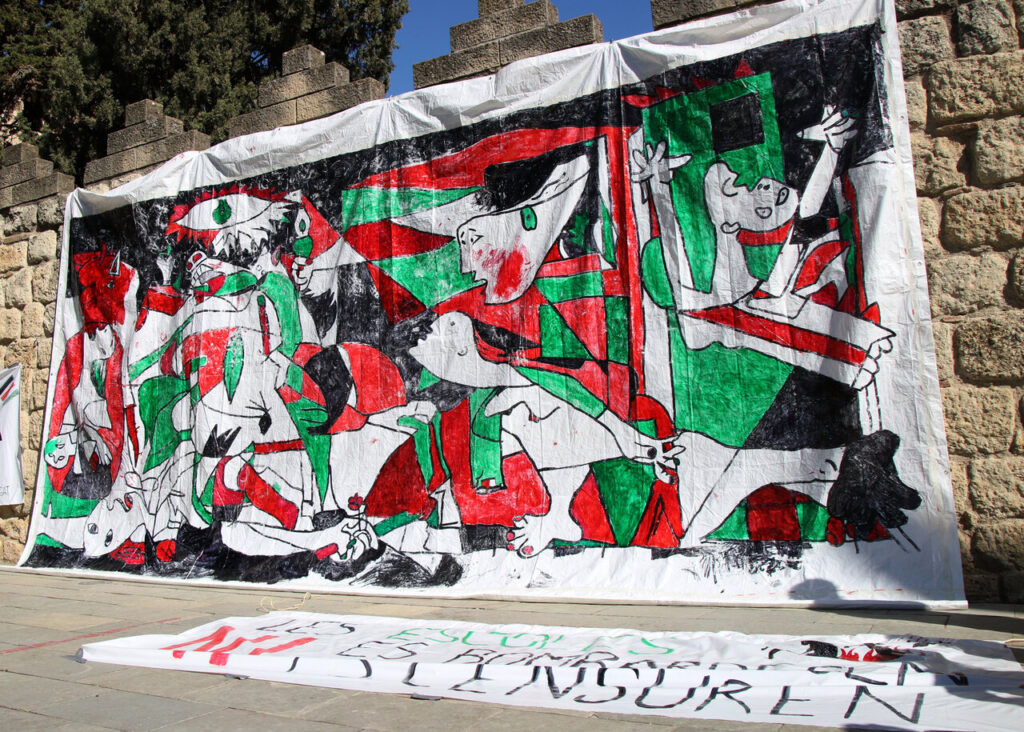Pablo Picasso’s Guernica stands as one of the most powerful anti-war paintings in modern history. Created in 1937 was Picasso’s internal organs response to the bombing of the Basque town of Guernica during the Spanish Civil War. Nazi German and Italian fascist forces allied with Francis Franco’s nationalist factions, attacked, resulting in the deaths of hundreds of civilians. Fearful at the atrocities, Picasso led his anger and sadness into this monumental black and white mural.

*Guernica* does not portray the literal event. Instead, it conveys the fear and confusion of war through a surreal, symbolic composition. The painting is filled with tortured figures, both human and animal, trapped in an expression of suffering and despair.
One of the central figures is a screaming mother embracing her dead child, a universal symbol of grief and loss.

By her side the bull is strong and faithful, often interpreted as a symbol of cruelty and stoic durability. A dying horse feels pain and controls the center of movement, representing an innocent victim of violence.
Other symbols reinforce the theme of destruction. A light bulb shaped like an eye that sees everything can be read as a symbol of technical fear or God’s witness. The shattered arms of the fallen soldier still hold their broken sword. A dislocated fragmented body filled the canvas, highlighting the chaos and inhumanity of modern warfare.

Monochromatic palette – black, white, gray strips images of romanticism. This violence is not beautiful, it is only suffering. Picasso refused the colour and refused to make the message even more immediate.
Not just a response to a single atrocity, Guernica has become a timeless cry for the cruelty of war and the suffering of innocent people. It speaks not only of the Spanish civil war, but also of the universal costs of conflict. Today, Guernica continues to be a symbol of peace and resistance. This is a reminder that art can witness injustice and awaken the conscience of the world.

Guernica, Reina Sofia Museum, Madrid)
Guernica as a symbol of pro-Palestinian protest
The use of Guernica in Gaza protests is a powerful symbolic gesture drawn from the painting’s enduring message of the horror of war and the suffering of innocent civilians.

Pablo Picasso’s Guernica has been featured prominently at pro-Palestinian rallies across Europe and serves as a powerful symbol to protest violence in Gaza and to draw parallels between historical and modern civilian suffering.
Madrid, Spain: In February 2024, pro-Palestinian protesters gathered at the Reina Sofia Museum, home to Picasso’s Guernica, to protest Israel’s actions in Gaza. They displayed the Palestinian flag, used anti-war messages from the painting to emphasize their stance and called for an end to the violence.
Guernica, Basque Country: On December 8th, 2023, over 3,000 people in the town of Guernica formed a mosaic of humanity depicting elements of Picasso’s Guernica and elements. The event, sponsored by the Guernica-Palestinian Citizens’ Initiative, aims to draw similarities between the 1937 bombing of Guernica and the ongoing conflict in Gaza.

San Sebastian, Spain: In March 2024, following a pro-Palestinian rally, hundreds of people participated in the “Daiin” next to the massive flag of Guernica, symbolizing the victims of Gaza and linking atrocities of the past and present.
Story Archives
These cases show how Guernica continues to resonate as a universal emblem to the fear of war, reused to highlight and protest modern conflicts that affect civilians.

Reported by Marzieh Rahmani

